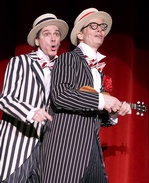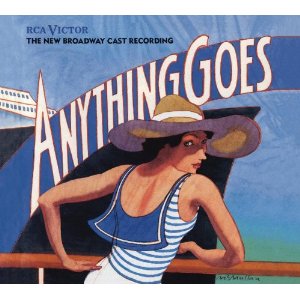SITE GUIDE
SEARCH
REVIEWS
REVIEW ARCHIVES
ADVERTISING AT CURTAINUP
FEATURES
NEWS
Etcetera and
Short Term Listings
LISTINGS
Broadway
Off-Broadway
NYC Restaurants
BOOKS and CDs
OTHER PLACES
Berkshires
London
California
New Jersey
DC
Philadelphia
Elsewhere
QUOTES
TKTS
PLAYWRIGHTS' ALBUMS
LETTERS TO EDITOR
FILM
LINKS
MISCELLANEOUS
Free Updates
Masthead
A CurtainUp Review
Old Hats
|
If you would sit/ Oh so close to me/ That would be nice/ If you would hug your arms right around me/ That would be snug/ Like it's supposed to be/ If we part I'll eat your heart/ So won't you please be nice. .— verses from the Musical Number: "Won't U Please B Nice" in Old Hats
|

L-R: David Shiner and Bill Irwin (Photo: Joan Marcus)
|
Outfitted in top hats, tails, baggy pants and horn-rims, Irwin and Shiner are an ideal team on stage. Often described as New Vaudevillians or New Wave clowns, these funnymen continue to evolve and redefine Clown art.
In the opening number, the duo play a game of theatrical one-upmanship, each trying to claim the spotlight, and alternately winning and losing at their narcissistic game. Whether its tossing their hats high into the air, and catching them by their brims, or upstaging one another with flashy moves, we see grandstanding in a very comic vein. This competition for being Number One will become a strong motif during the evening, and not-so-subtly play out in each comic skit.
Old Hats is not only loaded with laughs, but Irwin and Shiner suggest that the show is digitally loading itself before our eyes with comic material. Indeed we literally see that "loading" computer screen image at the onset of Act 1, projected onto a huge multi-media screen, which serves as a backdrop for many of the evening's vignettes.
While retaining some tried-and-true routines (Irwin signature gag of being sucked foot-first into the wings by a mysterious force is tucked into the show), Old Hats adds new-fangled material. Perhaps the most New Age skit is "The Businessman," in which Irwin postures as a frenetic businessman in the Big City, clutching an iPad as if it was an extension of his own arm. We watch as Irwin's character uses his high-tech toy for wheeling-and-dealing and connecting himself to the Digital World. What makes this skit not only pertinent but deeply psychological is that his consumer is earnestly-and surreally--struggling to master his high-tech gadget without being consumed by it. It begs the question: When it comes to human beings and the new technology in a dog-eat-dog world, how does one prevent the tail from wagging the dog?
The light-hearted show has its sobering, and even tragic-tinged, moments. This is most conspicuous in "The Hobo," where Shiner plays a tramp figure who would be quite at home in a Beckett play. With whiskey bottle in hand, Shiner's tramp trudges on stage and decides to sit down on a park bench right next to a trash can. Out of hunger, or perhaps idle curiosity, the man rummages through the trash can in search of things that might serve his present needs. We then watch as Shiner's hobo slowly pulls out, in various states of disrepair, a red rose, a stuffed teddy bear, a "real" dead cat, a (headless) Jack-in-the-box toy, and ultimately a satiny sheet that he ingeniously shapes into a surrogate lover. Of all the evening's vignettes, this one is the most poignant.
To add more comic energy to the proceedings Nellie McKay acts as an eccentric musical director and multi-talented performer on the piano, the ukulele, and cello. The blonde-haired McKay is cute as a Barbie doll but immediately establishes that she is somebody to be reckoned with, and more than just eye-candy. Whether she's crooning a song at the piano at the edge of the stage or joining Irwin and Shiner in one of their routines, she always asserts her savoir faire. Or as she puts it in her opening number, "Won't U Please B Nice:" "Oh don't you love this romancing/ Know that it's your life you're chancing. . ." McKay is nobody's fool here, and not only sings cannily about romantic love and feminism, but keeps the evening from slipping into that Old Boys school mind-set.
Beyond McKay and a spunky Band that spins out upbeat numbers, other supporting performers are recruited from the audience by Shiner. Once he pulls his "victims" on stage, he does a spoof of an old Western flick with his fledgling artists, overseeing them as they rehearsed their parts. It's hilarious to follow this melodrama-in-progress about an unfaithful mole and her vengeful boyfriend. Shiner bosses everybody on the film set, undermining all of their acting and directing attempts with his mocking gestures and facial expressions. After several rehearsals, however, he finally gave his nod to these would-be artists and handed a faux Oscar statuette to the film's make-shift director.
Having had the great good luck of seeing Bill Irwin in his Helen Hayes Award-winning performance at the Arena Stage in Washington, D.C. in 1985, and both Irwin and Shiner in Fool Moon on Broadway, I could appreciate this production as both a retrospective and au courant theatre event. It takes the best of their old material and builds upon it. There's nothing stale here. Even the stage spaghetti that is used creatively in one culinary scene has a fresh al dente twist here.
This clown show raises the bar on clowning, with its acrobatic finesse and intellectual bite. Irwin and Shiner put a spade to their clowning roots here and grow a brilliant new piece that has one foot in the past, one in the present, and surely plants them in the genealogical line of great clowns like Harpo Marx, Buster Keaton, and Charlie Chaplin.
|
Old Hats Created by Bill Irwin and David Shiner Directed by Tina Landau Cast: Bill Irwin, David Shiner. The Band: Nellie McKay (vocals/piano/ukulele/cello), Alexi David (Bass), Mike Dobson (percussion/Foley Artist), Tivon Pennicott (saxophone/flute) Sets and Costume Design: G. W. Mercier Sound: John Gromada Lighting: Peter Kaczorowski Projection Design: Wendall K. Harrington Stage Manager: David H. Lurie Music Director: Nellie McKay The Pershing Square Signature Center, at 480 W. 42nd Street Tickets: $25. Phone 212/244-7529 or visit www.signaturetheatre.org From: 2/12/13; opening 3/04/13; originally closing: 4/14/13; extended through 5/09/13. Tuesday through Friday @ 7:30pm; Saturday @ 8pm; Wednesday, Saturday, and Sunday matinees @ 2pm. No performance on March 24th. Running time: 1 hour; 50 minutes with 10 minute intermission. Reviewed by Deirdre Donovan based on press performance of 3/09/13 |
| REVIEW FEEDBACK Highlight one of the responses below and click "copy" or"CTRL+C"
Paste the highlighted text into the subject line (CTRL+ V): Feel free to add detailed comments in the body of the email. . .also the names and emails of any friends to whom you'd like us to forward a copy of this review. Visit Curtainup's Blog Annex For a feed to reviews and features as they are posted add http://curtainupnewlinks.blogspot.com to your reader Curtainup at Facebook . . . Curtainup at Twitter Subscribe to our FREE email updates: E-mail: esommer@curtainup.comesommer@curtainup.com put SUBSCRIBE CURTAINUP EMAIL UPDATE in the subject line and your full name and email address in the body of the message. If you can spare a minute, tell us how you came to CurtainUp and from what part of the country. |

Slings & Arrows- view 1st episode free
 Anything Goes Cast Recording
Anything Goes Cast RecordingOur review of the show
 Book of Mormon -CD
Book of Mormon -CDOur review of the show

